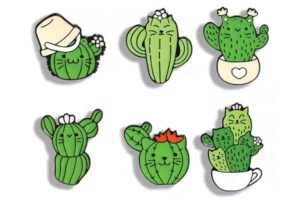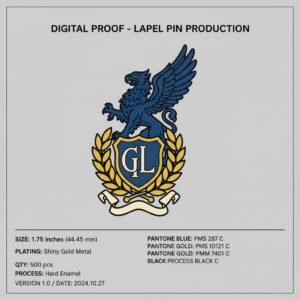Welcome! You have a brilliant idea for a custom lapel pin. Maybe it’s for your brand, a special event, or your growing team. But where do you start? The world of pin manufacturing can seem complex, filled with technical terms and critical decisions. One small mistake can lead to a batch of pins that don’t look right. It’s a frustrating thought.
This is where we step in. As a factory with over 250 skilled employees, we’ve seen it all. We’ve helped thousands of clients, just like you, turn their vision into a tangible, high-quality product. This guide is our way of sharing that experience directly with you. We will walk you through every single step, making the complex simple and giving you the confidence to create the perfect pin. For inspiration on how pins can elevate your brand, explore 15 Creative Ways to Use Custom Pins for Your Business.
Inhaltsverzeechnes
Chapter 1: The Foundation: Understanding Pin Types
Before you even think about design, you need to choose the style of your pin. This choice affects everything: the texture, the durability, the price, and the overall vibe. Let’s break down the main players.Hard Enamel vs. Soft Enamel: The Big Debate
This is the most common decision you’ll make. Though their names sound similar, the end products are remarkably different. Think of it like choosing between a glossy photograph and a textured painting.“The first question we always ask a client is about the intended use of the pin. Is it a corporate gift meant to last for years, or a fun, trendy item for a music festival? The answer almost always points directly to either hard or soft enamel.”
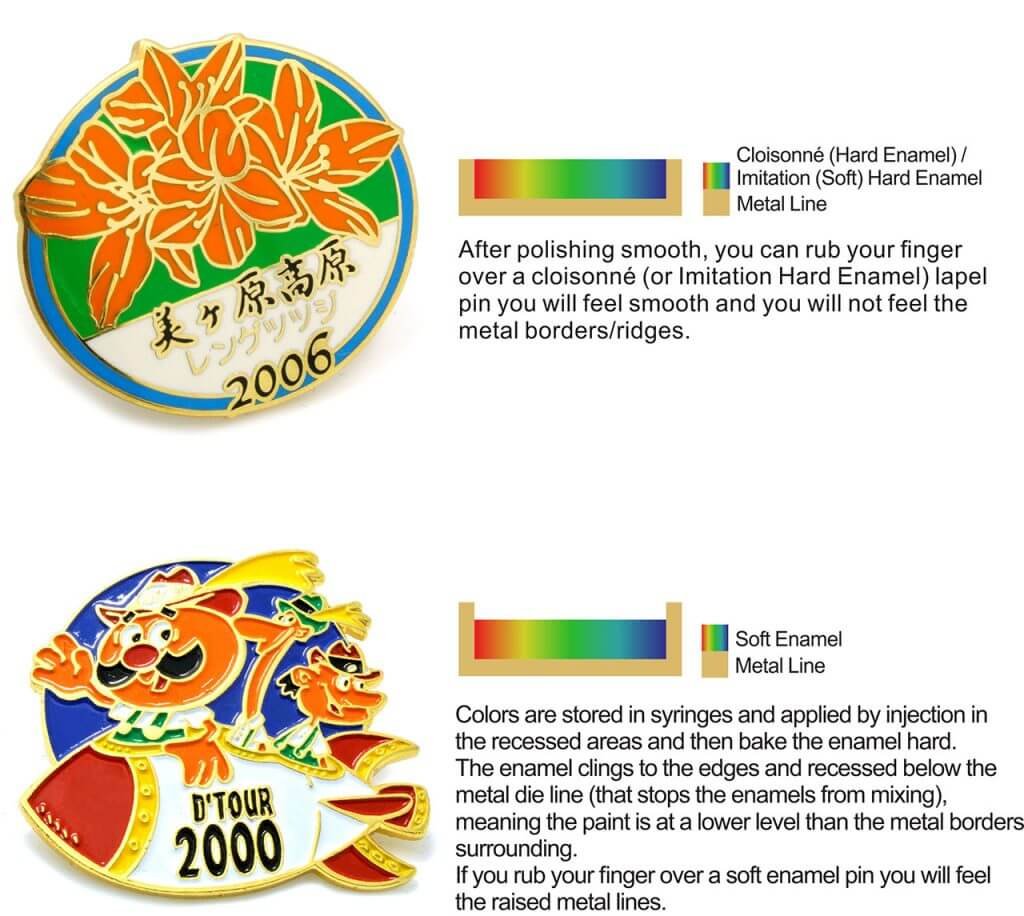
Hard Enamel vs. Soft Enamel: Quick Comparison
| Fonktioun | Hard Enamel (Cloisonné) | Soft Enamel |
|---|---|---|
| Surface Feel | Perfectly smooth and flat | Textured, with raised metal lines |
| Haltbarkeet | Extremely high, scratch-resistant | Good, can be enhanced with epoxy |
| Perceived Value | High, jewelry-like | Excellent, popular for retail/art |
| Best For | Corporate branding, awards, and luxury goods | Promotions, artist merch, trading pins |
| Cost | Higher | More cost-effective |
Other Key Pin Styles & Applications
Beyond enamel, a few other styles serve specific needs:- Die Struck Pins: Think pure, classic metal. These pins have no color fill. The design is created with raised and recessed metal areas. They are perfect for a timeless, elegant look. Learn more in our Guide to Creating Classic, No-Color Metal Pins.
- Printed Pins (Offset): What if your design has gradients, shadows, or even a photograph? That’s where printed pins come in, allowing for unlimited color and photorealistic detail. Discover when to choose printed pins for complex designs.
Chapter 2: Design for Manufacturing (DFM): The Blueprint for Success
This is where so many projects go wrong. A design that looks amazing on your computer screen might be impossible to produce as a 1.25-inch pin. To avoid issues, it’s essential to follow best practices. Our guide on the 10 Critical Design Tips for Creating an Unforgettable Lapel Pin is a must-read for any creator.
Rule #1: Every Color Needs a Home (Separated by Metal)
In an enamel pin, each area of color is like a tiny swimming pool. The raised metal lines are the walls of the pool, holding the liquid enamel in place. Therefore, every single color in your design must be fully enclosed by a metal line. Colors cannot touch each other directly. This is the most important rule in pin design.
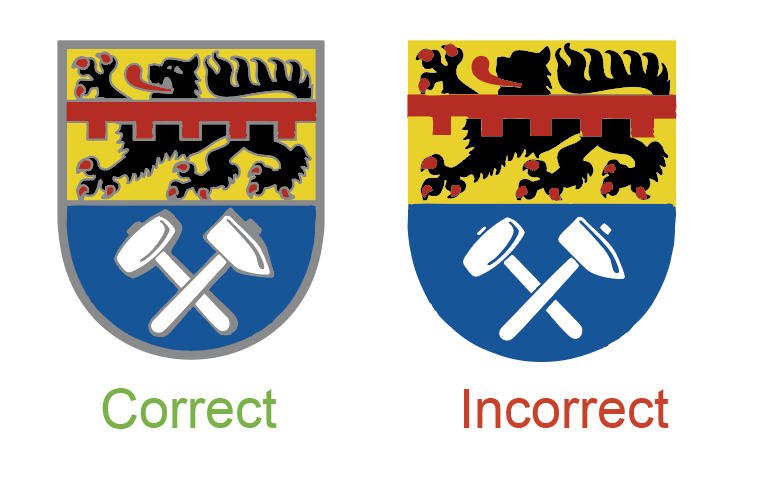
Rule #2: Respect the Minimums
Our machines and artisans are incredibly precise, but they are still working in the physical world. Lines that are too thin or color areas that are too small simply cannot be reliably produced.
Key Design Constraints for Manufacturing
| Design Element | Minimum Size / Thickness | Why It Matters |
|---|---|---|
| Metal Line Thickness | 0.2mm | Ensures the line is strong enough to hold enamel and not break during stamping. |
| Color Area (Enamel Fill) | 0.3mm | Guarantees that the enamel can flow into the area and fill it completely. |
| Cutouts (Inner Holes) | 1.5mm – 2.5mm | Prevents the pin from warping or breaking under the pressure of the stamping press. |
| Text Size (Sans-Serif) | 6pt | Ensures that letters are legible and the spaces within them can be filled properly. |
Rule #3: The Power of Pantone (PMS)
To guarantee your brand’s specific shade of blue is exactly right, the manufacturing world relies on the Pantone Matching System (PMS). It’s like a universal recipe book for color. To understand why this is so critical, check out our explainer: Why Pantone is Non-Negotiable for Your Brand.
Rule #4: Vector Files are King
Please provide your artwork as a vektor Datei (.AI, .EPS, or .SVG). A pixel-based file like a .JPG oder .PNG is not ideal and will need to be redrawn. For a clear explanation, see our Simple Guide to Vector Artwork for Non-Designers. For a more technical overview, this Raster vs. Vector explainer from Adobe is an excellent resource.
Chapter 3: Materials: The Core of Quality
The base metal of your pin affects its weight, perceived value, and suitability for certain designs.
- Iron: The workhorse, strong, reliable, and cost-effective, making it the most common choice for soft enamel pins.
- Brass: A step up, a bit heavier and softer, allowing for a cleaner stamp. It’s often the preferred material for premium hard enamel pins.
- Zinc Alloy: The specialist. Unlike iron and brass which are stamped, zinc alloy is cast from a molten state. This makes it the only choice for pins with complex 3D shapes, sharp internal corners, or large cutout areas. Unsure which mold type you need? Read our guide on 3D vs. 2D Molds for Custom Pins.
Chapter 4: Plating: The Finishing Touch
Plating is the thin layer of metallic finish applied to your pin. It’s what gives the metal lines their final color and shine. This choice dramatically influences the mood of your pin.
“A simple change in plating can take a design from playful to prestigious. Swapping shiny gold for an antique silver finish can make a pin feel like a historical artifact. It’s a powerful tool.”
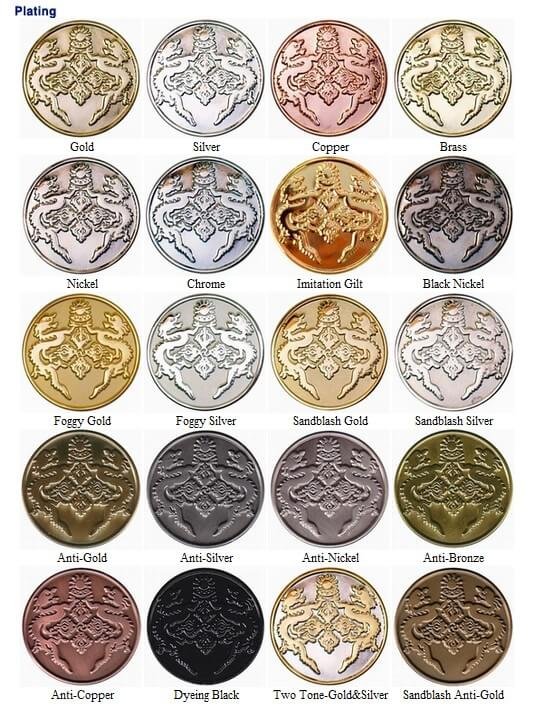
Popular Metal Plating Options
| Plating Type | Beschreiwung | Best For |
|---|---|---|
| Shiny Gold / Silver | Highly polished, mirror-like finish. Classic and bright. | Corporate logos, awards, designs that need to pop. |
| Antique Gold / Silver / Bronze | Chemically aged to create dark recessed areas, highlighting detail. | Designs with a lot of texture, vintage looks, military or commemorative pins. |
| Black Nickel | A sleek, dark, almost gunmetal finish. Modern and stylish. | Contrasting with bright colors, creating an edgy or contemporary feel. |
| Rainbow / Anodized | An iridescent, multi-colored finish where colors shift with the light. | Eye-catching and unique artistic pins. (Note: Only available for soft enamel). |
| Dyed Black | A matte, non-reflective black finish. | Creating a strong contrast, often used in artist pins for a bold outline. |
Choosing the right plating is an art. See them all in our Visual Guide to Metal Plating Options.
Chapter 5: Backings & Attachments: The Unsung Hero
How will your pin attach to a jacket, bag, or board? The backing might seem like a small detail, but it’s crucial for function and security. For a complete overview of all available options, consult Den Ultimate Guide fir Pin Backings & Attachments.

Common Pin Backing Options
| Backing Type | Beschreiwung | Use Case |
|---|---|---|
| Butterfly Clutch | The industry standard. A metal clutch you squeeze to release. | Default for most pins. Good for general use. |
| Rubber Clutch | A soft PVC clutch. More comfortable against skin and very secure. | Wearable items, artist pins, a popular and affordable upgrade. |
| Deluxe / Locking Clutch | A spring-loaded mechanism that locks onto the post. Very secure. | Preventing loss of valuable or sentimental pins. Great for traders. |
| Safety Pin | A traditional brooch-style pin back. | Larger pins or for attaching to fabrics where a post won’t work. |
| Magnets | Two powerful magnets (one on the pin, one for inside the clothing). | Delicate fabrics like silk or for anyone who doesn’t want a pinhole. |
Pro Tip: For pins larger than 1.25 inches, always use two posts on the back. This prevents the pin from spinning and keeps it securely in place.
Chapter 6: Inside the Factory: How Your Pin is Born
Ever wondered what happens after you approve your design? It’s a fascinating blend of heavy machinery and skilled handwork. Here is the simplified journey from a digital file to a finished product.
Mold Creation: Your vector artwork guides a CNC machine to engrave your design, in reverse, into a solid block of steel. This mold is the heart of the production process.
Stamping: A massive hydraulic press, applying several tons of pressure, strikes strips of your chosen base metal (iron or brass) against the mold. This creates the flat pin “blanks” with your design impressed into them.
Trimming: The individual pin shapes are cut out from the metal strips.
Poléieren: The raw metal pins are tumbled and polished to smooth out any rough edges from the stamping process.
Attachment Welding: The backing posts are carefully welded onto the back of each pin.
Plating: The pins are electroplated in a chemical bath to give them their final metal finish (e.g., gold, black nickel).
Enamel Filling: This is where the artistry shines. Skilled workers use small syringes to carefully fill each recessed area of the pin with liquid enamel color, one color at a time.
Baking: The pins are baked in a low-temperature oven to cure and harden the enamel.
Final Polishing (Hard Enamel Only): Hard enamel pins go through an additional, rigorous grinding and polishing process to make the surface perfectly flat and smooth.
Quality Control: Every single pin is inspected by hand. We check for color accuracy, scratches, dust in the enamel, and any other imperfections. Only the best ones make it through.
Chapter 7: Choosing the Right Partner: Factory vs. Middleman
You’ve perfected your design. Now you need someone to make it. This is a critical choice. Our detailed guide explains how to choose a reliable custom pin manufacturer and avoid potential issues.
“The biggest frustration for buyers comes from communication breakdown. When there are multiple layers between you and the people actually making the product, details get lost. Working factory-direct removes that friction. You’re talking to the experts.”
Here’s what to look for in a manufacturing partner:
- Deep Experience: Do they showcase a wide variety of complex pins? An experienced factory has solved problems you haven’t even thought of yet. See an example in our case study on employee morale pins.
- Transparent Communication: Are they responsive and do they offer expert advice?
- Clear Quoting: The quote should be simple and all-inclusive.
- A Solid Guarantee: A reputable factory will stand by their work.
Working directly with a factory gives you better prices and a higher quality final product. To prevent issues, be sure to read about the top 7 mistakes to avoid when ordering custom pins.
Chapter 8: The Standard Procurement Workflow: From Quote to Delivery
So, what does the ordering process actually look like? It’s a straightforward path designed to ensure you get exactly what you want, with no surprises.
- Request for Quote (RFQ): This is the start. You send us your artwork (even a rough sketch is okay!), the desired size, the quantity you need, and the pin style you’re thinking of.
- Formal Quote & Digital Proof: Within 24 hours, our team will send back two things:
- A detailed, itemized quote with all costs clearly laid out.
- A professional digital artwork proof. This is our technical blueprint for your pin. It will show the final line art, Pantone (PMS) color codes, size, plating choice, and backing type.
- Revisiounen & Approval: This is your chance to make changes. Need a color tweaked? Want to make the text a bit bigger? We offer unlimited revisions at no charge. We will not produce a single pin until you reply with your formal approval of this proof.
- Production: Once you approve the proof and submit payment, your order goes to the factory floor. This is where the magic happens! Production typically takes 2-3 weeks.
- Shipping: After passing our final quality control check, your pins are securely packaged and shipped directly to your door via a reliable international courier like FedEx or DHL.
Chapter 9: Frequently Asked Questions (FAQ)
We get these questions every day. Here are the clear, straightforward answers you need.
- 1. What is your Minimum Order Quantity (MOQ)?
- Our standard MOQ is 100 pins per design. Because the setup process (mold creation, machine configuration) is the most labor-intensive part, making smaller quantities becomes very expensive per piece. The 100-unit mark is where the price becomes economical.
- 2. What is a “mold fee”? Is it really a one-time charge?
- Yes, absolutely. The mold fee covers the cost of creating the physical steel mold for your specific design. We securely store your mold for 2 years. If you place a reorder of the exact same pin within that time, you will not pay the mold fee again.
- 3. What is the average total turnaround time?
- From the moment you approve your proof, you should plan for about 3-4 weeks. This breaks down into roughly 2-3 weeks for production and 5-7 days for international air shipping.
- 4. I don’t have a professional design, just an idea. Can you help?
- Of course. Our team of artists can turn your rough sketch, logo, or even just a detailed description into a production-ready digital proof, completely free of charge.
- 5. Can I order a single physical sample before the full run?
- Yes, creating a pre-production sample is possible. This is a great option for very large orders (5,000+ units) or for clients who need to have the physical product for final approval. Please note that this process involves a sampling fee and will add about 2-3 weeks to the overall timeline.
- 6. What happens if I find a mistake or defect in my order?
- Your order is guaranteed to match the digital proof that you approved. If you receive your pins and they have a manufacturing defect or do not match the proof, we will remake the defective pins for you at our cost.
- 7. How much does a custom pin cost?
- The price is based on the size, quantity, pin style, and number of colors. For a complete overview, please read Understanding Custom Pin Pricing: A Complete Breakdown an How Pin Size and Complexity Affect the Final Cost.
- 8. Can you make pins with special features like glitter or cutouts?
- Yes! We love special features. Explore the possibilities in our Guide to Special Effects for Pins (Glitter, Glow-in-the-Dark, and More).
- 9. What are your payment terms?
- For new customers, we require payment in full after the artwork proof is approved but before we begin mass production. We accept all major credit cards and wire transfers.
- 10. Do you offer custom packaging?
- We do. While each pin comes in its own individual poly bag for protection, we can also create custom options. See all the options in A Buyer’s Guide to Custom Pin Packaging.


